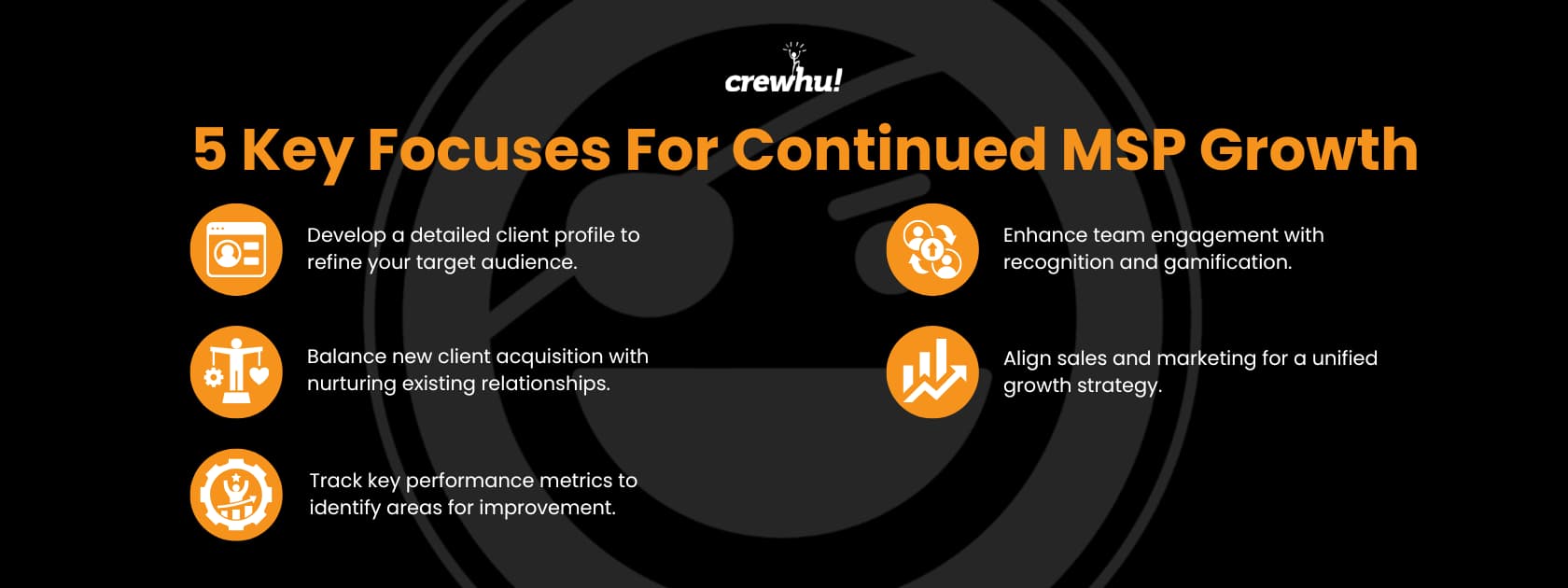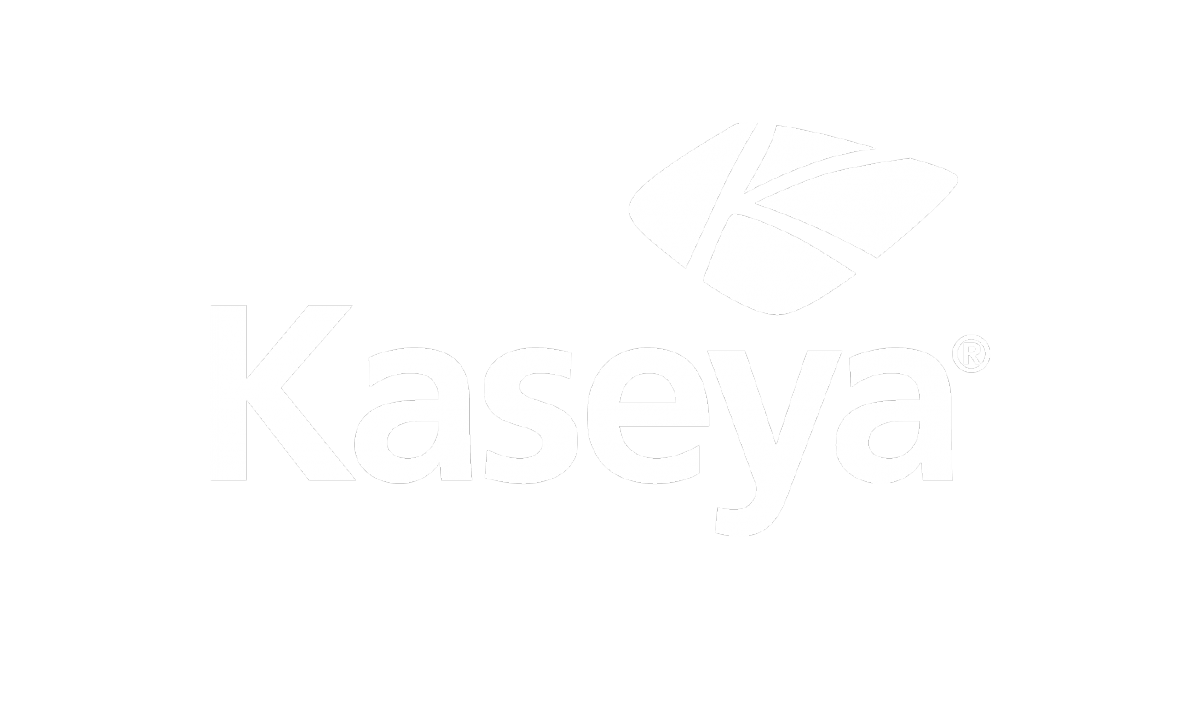5 Key Focuses for Continued MSP Growth

Learn how a multi-faceted and data-driven approach to growth can lead to positive change – including better customer relationships, enhanced productivity, and lasting success.

As a Managed Service Provider (MSP), staying ahead means implementing strategies that foster long-term growth. Many businesses focus on client acquisition, but sustainable expansion needs a balanced approach.
That includes:
- Nurturing existing relationships
- Leveraging data-driven insights
- Motivating your internal team
Understanding key trends and tracking the right metrics can enhance customer relationships, boost team productivity, and drive overall success. Let’s take a look at some proven tips and tricks for making that happen.
1. Develop a Tailored Client Profile
Understanding your ideal customer is critical to sustainable growth. You need to know who you should be selling to!
Start by analyzing your top-performing accounts—what common characteristics do they share? Identifying these traits helps define your ideal client profile, ensuring you attract businesses that align with your goals and services.
A few things to keep in mind:
- Your ideal client should have a strong growth strategy, because their expansion translates into new opportunities for your MSP.
- Assess their industry, company size, and technological needs to ensure a strategic fit.
- When you attract clients with compatible business models, you can deliver higher value and establish long-term relationships.
- Your perfect client profile may evolve over time due to market shifts, economic changes, or industry regulations. For instance, the IT landscape is constantly evolving with compliance laws, cybersecurity threats, and emerging technologies that impact the services your clients need.
Regularly reassess your client profiles and adapt your marketing messages accordingly. Utilize customer feedback and market research to stay ahead of industry trends and remain a valuable resource for your clients.
2. Prioritize Existing and New Clients
Acquiring new clients is essential, but don’t overlook the value of your current customer base. Many MSPs fall into the trap of focusing heavily on new leads while neglecting their existing customers. It’s important to remember that your current clients generate consistent revenue and provide valuable insights into areas for improvement.
A successful MSP should operate as if it has two businesses—client acquisition and client retention. Dedicate resources to nurturing existing client relationships through proactive communication, personalized service, monitoring satisfaction matrics, and continuous improvement based on feedback.
Key Metrics to Monitor:
- Customer Satisfaction Score (CSAT): Tracks client sentiment related to specific service interactions. A low CSAT score signals areas needing attention.
- Net Promoter Score (NPS): Measures overall customer loyalty and the likelihood of referrals, providing a broader view of client relationships.
- Conversion Rates: Analyze CSAT trends alongside conversion rates to identify improvement opportunities and enhance customer retention.
Using data-driven insights to refine service offerings can improve customer retention. Integrating platforms like Crewhu with your PSA, ticketing systems, and email platforms allows you to collect real-time feedback and address customer concerns before they escalate into major issues.
You may also want to consider implementing loyalty programs or exclusive benefits for long-term clients. Incentivizing retention can help you maintain a stable revenue stream while reinforcing trust and satisfaction.
3. Align Sales & Marketing for Strategic Growth
Sales and marketing need to work together to achieve shared goals–especially at MSPs. Marketing needs to generate qualified leads, while sales needs to provide good feedback to refine marketing efforts..Clear communication helps both teams understand business objectives, contribute effectively to lead generation and customer acquisition, and maximize efficiency.
A few key considerations:
- Define lead generation targets: Establish clear goals based on average deal size and close ratios to determine how many leads are needed for successful conversion.
- Identify acquisition channels: Analyze data to understand where your highest-quality leads come from and optimize marketing spend accordingly.
- Create consistent messaging: Ensure that marketing content aligns with the sales process to provide a unified customer experience.
- Leverage community engagement: Utilize social media and local networking to build brand awareness and establish trust within target markets.
A well-aligned sales and marketing strategy helps streamline lead generation efforts, improve conversion rates, and drive consistent revenue growth.
4. Leverage Data-Driven Decision Making
Successful MSPs don’t rely on guesswork. They use data to inform business decisions. Track key performance metrics to identify areas for improvement, measure the success of new initiatives, and refine your growth strategies.
Here are a few metrics that matter:
- Customer churn rate: Understand why clients leave to help you implement retention strategies and improve service quality.
- Average revenue per user (ARPU): Track this to assess profitability and identify opportunities for upselling.
- First response time (FRT): Faster response times lead to higher customer satisfaction and improved brand reputation.
- Employee satisfaction scores: Happy employees lead to better customer experiences, making internal feedback an important metric.
By analyzing these data points, you can make informed decisions that drive business growth and improve overall operational efficiency.
5. Boost Productivity with Employee Recognition & Gamification
A motivated team means better customer service. Employee engagement directly impacts CSAT and NPS scores, so you need to recognize and reward your team’s contributions.Employees feeling undervalued or disconnected can lead to reduced productivity, higher turnover rates, and ultimately, a decline in service quality.
Gamification and MSP Success
Gamification helps engage employees, encourage friendly competition, and drive performance. By incorporating game-like elements into daily workflows, you can improve motivation and track progress in a measurable way.
Here are a few typical gamification strategies:
- Points & Badges: Reward employees for achievements and milestones, such as resolving a high number of support tickets or receiving positive customer feedback.
- Leaderboards: Foster a spirit of healthy competition by displaying rankings based on performance metrics.
- Challenges & Progress Bars: Set individual or team goals with visual progress indicators to keep motivation high.
- Rewards & Recognition Badges: Celebrate success with meaningful incentives, such as gift cards, extra time off, or public acknowledgment.
Implementing gamification and recognition strategies not only enhances employee engagement but also improves overall service delivery–directly impacting customer satisfaction. A platform like Crewhu enables you to track KPIs, improve morale, and foster a culture of recognition and growth.
Achieving Sustainable Growth For Your MSP
A good growth strategy requires a multi-faceted approach that includes targeting the right clients, nurturing existing relationships with real-time metrics, aligning sales and marketing efforts, and engaging employees through automatic rewards.
Crewhu empowers MSPs with gamification and recognition tools that drive engagement, productivity, and customer satisfaction. By implementing these strategies and focusing on key metrics, you can accelerate business growth while maintaining a strong, motivated team.
Ready to take your MSP to the next level? Start optimizing your processes with Crewhu today. Contact our team or book a demo to learn more.
Topics: employee recognition, MSP growth, Microsoft Azure, MSP metrics, metrics that matter, client profile






